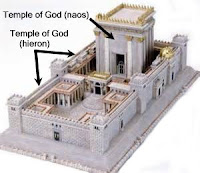 While the Greek words ieron and naos are both translated "temple" in the New Testament, what's the difference, if any, between these two terms? Here's what I found when I researched the answer to this question:
While the Greek words ieron and naos are both translated "temple" in the New Testament, what's the difference, if any, between these two terms? Here's what I found when I researched the answer to this question:
Richard Trench in his classic book Synonyms of the New Testament writes that ieron refers to "the whole compass of the sacred enclosure, the temenos [i.e. a piece of land marked off from common use and assigned as an official domain, especially to a king, chief, or god], including the outer courts, the porches, porticoes, and other buildings subordinated to the temple itself". In distinction to this, Trench says that naos signifies "the proper habitation of God...the oikos tou theou...[it] is the temple itself, that by especial right so called, being the heart and centre of the whole; the Holy, and the Holy of Holies...'temple' in its more limited and auguster sense."1
J. H. Thayer in his Greek-English Lexicon of the New Testament says that ieron has reference to "the whole temple, the entire consecrated enclosure", while the word naos is "used of the temple at Jerusalem, but only of the sacred edifice (or sanctuary itself), consisting of the Holy place and the Holy of holies".2
And Moulton and Milligan, in The Vocabulary of the Greek Testament, write that "the word [naos] is apparently to be distinguished from the wider and more general ieron, 'the temple precincts'...naos, which in both LXX and NT is applied to the temple at Jerusalem".3
So to put it simply, I would say that while ieron refers to "the temple precincts" (as noted above), naos refers to the temple proper.
So to put it simply, I would say that while ieron refers to "the temple precincts" (as noted above), naos refers to the temple proper.
ENDNOTES:
1 Richard Chenevix Trench, Synonyms of the New Testament (Grand Rapids: William B. Eerdmans Publishing Co., 1958), pp. 10-12.
2 Joseph Henry Thayer, A Greek-English Lexicon of the New Testament (Grand Rapids: Baker Book House Co., 1977), p. 422.
3 J. H. Moulton and George Milligan, The Vocabulary of the Greek Testament (Grand Rapids: William B. Eerdmans Publishing Co., 1972), p. 422.